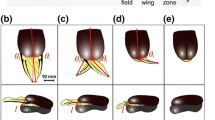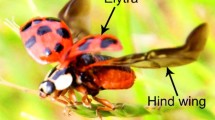Abstract
The present work aimed to reveal the functional morphology and bending characteristics of the worker honeybee (Apis mellifera) forewing. Honeybee wings including the forewing and hindwing, which are mainly composed of veins and membranes, are a kind of typical hierarchical biomaterials. We investigated the cross-sections of membranes, veins and wing hairs through Scanning Electron Microscopy (SEM). Based on the microscopic observation, it was found that the vein is a thick-walled cylinder, and the membrane possesses multilayered structure and so does the wing hair which shows the thread surface. At the vein-membrane conjunctive position, membranes and veins are assembled seamlessly and veins are packed smoothly and tightly by membranes into a whole, allowing honeybees to perform excellent flapping flight. In such a case, we also conducted the cantilevered bending experiment of honeybee forewing to explore their bending characteristics using a MTS Tytron 250 micro force tester. Experiment results indicate that the anti-bending capacity of the forewing along the spanwise direction is higher than that along the chordwise direction which is partly caused by the wing corrugation along the wing span detected by the micro-Computed Tomography (micro-CT), and ventral load bearing ability is better than dorsal one along the spanwise and chordwise direction of the wing which is due to the stress-stiffening of membranes. It could be concluded that the structural configuration of the wing is closely relevant to wing biomechanical behaviors. All results above would provide a significant support for the design of bioinspired wings for Flapping Micro Aerial Vehicles (FMAV).
Similar content being viewed by others
References
Jensen M. Biology and physics of locust flight. III. The aerodynamics of locust flight. Philosophical Transactions of the Royal Society B Biological Sciences, 1956, 239, 511–552.
Weis-Fogh T. Biology and physics of locust flight I V. Notes on sensory mechanisms in locust flight. Philosophical Transactions of the Royal Society B Biological Sciences, 1956, 239, 553–584.
Wootton R J. Support and deformability in insect wings. Journal of Zoology, 1981, 193, 447–468.
Wootton R J. Geometry and mechanics of insect hindwing fans: A modelling approach. Proceedings of the Royal Society B Biological Sciences, 1995, 262, 181–187.
Wootton R J, Evans K E, Herbert R, Smith C W. The hind wing of the desert locust (Schistocerca gregaria Forskål). I. Functional morphology and mode of operation. Journal of Experimental Biology, 2000, 203, 2921–2931.
Smith C W, Herbert R, Wootton R J, Evans K E. The hind wing of the desert locust (Schistocerca gregaria Forskål). II. Mechanical properties and functioning of the membrane. Journal of Experimental Biology, 2000, 203, 2933–2943.
Herbert R, Young P G, Smith C W, Wootton R J, Evans K E. The hind wing of the desert locust (Schistocerca gregaria Forskal). III. A finite element analysis of a deployable structure. Journal of Experimental Biology, 2000, 203, 2945–2955.
Song F, Xiao K W, Bai K, Bai Y L. Microstructure and nanomechanical properties of the wing membrane of dragonfly. Materials Science and Engineering: A, 2007, 457, 254–260.
Zhao Y R, Wang D S, Tong J, Sun J Y. Nanomechanical behaviour of the membranous wings of dragonfly pantala flavescens fabricius. Journal of Bionic Engineering, 2016, 13, 388–396.
Wang X S, Li Y, Shi Y F. Effects of sandwich microstructures on mechanical behaviors of dragonfly wing vein. Composites Science and Technology, 2008, 68, 186–192.
Rajabi H, Moghadami M, Darvizeh A. Investigation of microstructure, natural frequencies and vibration modes of dragonfly wing. Journal of Bionic Engineering, 2011, 8, 165–174.
Zhao H X, Yin Y J, Zhong Z. Micro and nano structures and morphologies on the wing veins of dragonflies. Chinese Science Bulletin, 2010, 55, 1993–1995.
Zhao H, Yin Y, Zhong Z. Assembly modes of dragonfly wings. Microscopy Research and Technique, 2011, 74, 1134–1138.
Chen Y L, Wang X S, Ren H H, Li X D. An organic junction between the vein and membrane of the dragonfly wing. Chinese Science Bulletin, 2011, 56, 1658–1660.
Chen Y L, Wang X S, Ren H H, Yin H, Jia S. Hierarchical dragonfly wing: Microstructure-biomechanical behavior relations. Journal of Bionic Engineering, 2012, 9, 185–191.
Ren L Q, Li X J. Functional characteristics of dragonfly wings and its bionic investigation progress. Science China Technological Sciences, 2013, 56, 884–897.
Ren H H, Wang X S, Li X D, Chen Y L. Effects of dragonfly wing structure on the dynamic performances. Journal of Bionic Engineering, 2013, 10, 28–38.
Ma Y, Ning J G, Ren H L, Zhang P F, Zhao H Y. The function of resilin in honeybee wings. Journal of Experimental Biology, 2015, 218, 2136–2142.
Combes S A, Daniel T L. Flexural stiffness in insect wings I. Scaling and the influence of wing venation. Journal of Experimental Biology, 2003, 206, 2979–2987.
Combes S A, Daniel T L. Flexural stiffness in insect wings II. Spatial distribution and dynamic wing bending. Journal of Experimental Biology, 2003, 206, 2989–2997.
Ganguli R, Gorb S, Lehmann F O, Mukherjee S. An experimental and numerical study of Calliphora wing structure. Experimental Mechanics, 2010, 50, 1183–1197.
Mengesha T E, Vallance R R, Mittal R. Stiffness of desiccating insect wings. Bioinspiration & Biomimetics, 2011, 6, 014001.
Lehmann F O, Gorb S, Nasir N, Schutzner P. Elastic deformation and energy loss of flapping fly wings. Journal of Experimental Biology, 2011, 214, 2949–2961.
Sunada S, Zeng L J, Kawachi K. The relationship between dragonfly wing structure and torsional deformation. Journal of Theoretical Biology, 1998, 193, 39–45.
Buehler M J. Tu(r)ning weakness to strength. Nano Today, 2010, 5, 379–383.
Gupta H S, Seto J, Wagermaier W, Zaslansky P, Boesecke P, Fratzl P. Cooperative deformation of mineral and collagen in bone at the nanoscale. Proceedings of the National Academy of Sciences of the United States of America, 2006, 103, 17741
Gao H J. Application of fracture mechanics concepts to hierarchical biomechanics of bone and bone-like materials. International Journal of Fracture, 2006, 138, 101.
Vincent J F V, Wegst U G K. Design and mechanical properties of insect cuticle. Arthropod Structure and Development, 2004, 33, 187–199.
Kesel A B, Philippi U, Nachtigall W. Biomechanical aspects of the insect wing: An analysis using the finite element method. Computers in Biology and Medicine, 1998, 28, 423–437.
Rees C J C. Form and function in corrugated insect wings. Nature, 1975, 256, 200–203.
Ha N S, Jin T L, Goo N S, Park H C. Anisotropy and non-homogeneity of an Allomyrina Dichotoma beetle hind wing membrane. Bioinspiration & Biomimetics, 2011, 6, 046003.
Author information
Authors and Affiliations
Corresponding author
Rights and permissions
About this article
Cite this article
Ma, Y., Ren, H., Ning, J. et al. Functional Morphology and Bending Characteristics of the Honeybee Forewing. J Bionic Eng 14, 111–118 (2017). https://doi.org/10.1016/S1672-6529(16)60382-7
Published:
Issue Date:
DOI: https://doi.org/10.1016/S1672-6529(16)60382-7




